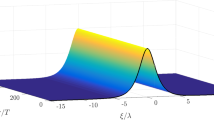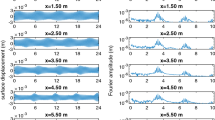Abstract
We analyze surface wave data taken in Currituck Sound, North Carolina, during a storm on 4 February 2002. Our focus is on the application of nonlinear Fourier analysis (NLFA) methods (Osborne 2010) to analyze the data set: The approach spectrally decomposes a nonlinear wave field into sine waves, Stokes waves, and phase-locked Stokes waves otherwise known as breather trains. Breathers are nonlinear beats, or packets which “breathe” up and down smoothly over cycle times of minutes to hours. The maximum amplitudes of the packets during the cycle have a largest central wave whose properties are often associated with the study of “rogue waves.” The mathematical physics of the nonlinear Schrödinger (NLS) equation is assumed and the methods of algebraic geometry are applied to give the nonlinear spectral representation. The distinguishing characteristic of the NLFA method is its ability to spectrally decompose a time series into its nonlinear coherent structures (Stokes waves and breathers) rather than just sine waves. This is done by the implementation of multidimensional, quasi-periodic Fourier series, rather than ordinary Fourier series. To determine preliminary estimates of nonlinearity, we use the significant wave height Hs, the peak period Tp, and the length of the time series T. The time series analyzed here have 8192 points and T =1677.72 s = 27.96 min. Near the peak of the storm, we find Hs ≈ 0.55 m, Tp ≈ 2.4 s so that for the wave steepness of a near Gaussian process, \({S} = \left (\pi ^{5/2}/g\right )H_{s}/{T}_{p}^{2}\), we find S ≈ 0.17, quite high for ocean waves. Likewise, we estimate the Benjamin-Feir (BF) parameter for a near Gaussian process, \({I_{BF}} = \left (\pi ^{5/2}/g \right ) H_{s} T/{T}_{p}^{3}\), and we find IBF ≈ 119. Since the BF parameter describes the nonlinear behavior of the modulational instability, leading to the formation of breather packets in a measured wave train, we find the IBF for these storm waves to be a surprisingly high number. This is because IBF, as derived here, roughly estimates the number of breather trains in a near Gaussian time series. The BF parameter suggests that there are roughly 119 breather trains in a time series of length 28 min near the peak of the storm, meaning that we would have average breather packets of about 14 s each with about 5-6 waves in each packet. Can these surprising results, estimated from simple parameters, be true from the point of view of the complex nonlinear wave dynamics of the BF instability and the NLS equation? We analyze the data set with the NLFA to verify, from a nonlinear spectral point of view, the presence of large numbers of breather trains and we determine many of their properties, including the rise time for the breathers to grow to their maximum amplitudes from a quiescent initial state. Energetically, about 95% of the NLFA components are found to consist of breather trains; the remaining small amplitude components are sine and Stokes waves. The presence of a large number of densely packed breather trains suggests an interpretation of the data in terms of breather turbulence, highly nonlinear integrable turbulence theoretically predicted for the NLS equation, providing an interesting paradigm for the nonlinear wave motion, in contrast to the random phase Gaussian approximation often considered in the analysis of data.




























Similar content being viewed by others
References
Ablowitz MJ, Segur H (1981) Solitons and the inverse scattering transform. SIAM, Philadelphia
Akhmediev N, Elconskii VM, Kulagin NE (1987) Exact first order solutions of the nonlinear Schrödinger equation. Theor Math Phys 72:809
Ardag D, Resio DT (2017) Inconsistencies in spectral evolution produced by operational models due to inaccurate estimates of nonlinear interactions. Accepted by Journal of Physical Oceanography
Babanin AV, Young IR, Banner ML (2001) Breaking probabilities for dominant surface waves on water of finite constant depth. J Geophys Res 106(11):659–11676
Badulin SI, Pushkarev AN, Resio DT, Zakharov VE (2005) Self-similarity of wind driven seas. Nonlinear Process Geophys 12(6):891–945
Badulin S, Babanin A, Zakharov V, Resio DT (2007) Weakly turbulent laws of wind-wave growth. Journal of Fluid Mechanics - J. Fluid Mech. 591:339–378
Belokolos ED, Bobenko AI, Enol’skii BZ, Its AR, Matveev VB (1994) Algebro-geometric approach to nonlinear integrable equations. Springer, Berlin
Benjamin TB, Feir JE (1967) The disintegration of wave trains on deep water. Part 1 J Fluid Mech 27:417430
Bitner-Gregersen EM, Gramstad O (2015) ROGUE WAVES: impact on ships and offshore structures. DNV GL Strategic Research and Innovation Position Paper, 0502015
Costa A, Osborne AR, Resio DT, Alessio S, Chrivì E, Saggese E, Bellomo K, Long C (2014) Soliton turbulence in shallow water ocean surface waves. PRL 113:108501
Davis RE, Regier LA (1977) Methods for estimating directional wave spectra from multi-element arrays. J Mar Res 35:453–477
Dean RG (1990) Freak waves: a possible explanation. In: Dean R G (ed) A Torum and OT Gudmestad. Kluwer, Dordrecht, pp 609–612
Dean RG, Dalrymple RA (1991) Water wave mechanics for engineers and scientists. World Scientific, Singapore
El GA, Kamchatnov AM (2005) Kinetic equation for dense soliton gas. Phys Rev Lett 95:204101
Goda Y (2010) Random seas and design of maritime structures. World Scientific, Singapore
Hasimoto H, Ono H (1972) Nonlinear modulation of gravity waves. J Phys Soc Jpn 33:805–811
Hasselmann K (1962) On the non-linear energy transfer in a gravity wave spectrum, Part 1. General theory. J Fluid Mech 12:481500
Hasselmann K (1963a) On the non-linear transfer in a gravity wave spectrum, Part 2, Conservation theory, wave-particle correspondence, irreversibility. J Fluid Mech 15:273281
Hasselmann K (1963b) On the non-linear transfer in a gravity wave spectrum, Part 3. Evaluation of energy flux and sea-swell interactions for a Neumann spectrum. J Fluid Mech 15:385398
Holthuijsen LH (2007) Waves in oceanic and coastal waters. Cambridge University Press, Cambridge, pp ISBN0-521-86028-8
Janssen PAEM (2004) The interaction of ocean waves and wind. Cambridge University Press, Cambridge
Johnson RS (1997) A modern introduction to the mathematical theory of water waves. Cambridge University Press, Cambridge
Kharif CE, Pelinovsky E, Slunyaev AS (2009) Rogue waves in the ocean. Springer, Berlin
Kinsman B (1965) Wind waves: their generation and propagation on the ocean surface. Dover, New York
Komen GJ, Cavaleri L, Donelan M, Hasselmann K, Hasselmann S, Janssen PAEM (1994) Dynamics and modelling of ocean waves. Cambridge University Press, Cambridge
Korotkevich AO, Pushkarev AN, Resio DT, Zakharov VE (2007) Numerical verification of the Hasselmann equation. In: Kundu A (ed) Tsunami and nonlinear waves, 135–172. Springer, xi,316, pp ISBN: 978-3-540-71255-8; physics/0702034
Kotljarov VP, Its AR (1976) Dopov. Akad. Nauk. Ukr. RSR. A 11, 9650968 (in Ukranian)
Lamb H (1916) Hydrodynamics. Cambridge University Press, Cambridge
Long CE, Resio DT (2004) Directional wave observations. In: Currituck Sound, North Carolina, conference: proceedings, 8th Int. workshop of wave hindcasting and forecasting, Hawaii
Long CE, Resio DT (2007) Wind wave spectral observations in Currituck Sound, North Carolina. J Geophys Res 112:1–21, C05001. https://doi.org/10.1029/2006JC003835
Longuet-Higgins MS (1952) On the statistical distribution of the heights of sea waves. J Marine Res 11 (3):245–266
Longuet-Higgins MS, Stewart RW (1960) Changes in the form of short gravity waves on long waves and tidal currents. J Fluid Mech 8:565583
Ma YC (1979) The perturbed plane-wave solutions of the cubic Schrödinger equation. Stud Appl Math 60:43
Mei CC (1983) The applied dynamics of ocean surface waves. Wiley, New York
Osborne AR (1982) The simulation and measurement of random ocean wave statistics. In: Osborne AR, Malanotte-Rizzoli P (eds) Topics in ocean physics. North- Holland, Amsterdam
Osborne AR (1993) The behavior of solitons in random-function solutions of the periodic Korteweg-deVries equation. Phys Rev Lett 71(19):31153118
Osborne AR (2010) Nonlinear ocean waves and the inverse scattering transform. Academic Press, Boston
Osborne AR (2017) (2018) Nonlinear Fourier methods for ocean waves. Procedia IUTAM, IUTAM Symposium Wind Waves, 48, London
Pelinovsky E, Kharif C (2008) Extreme ocean waves. Springer, Berlin
Peregrine DH (1983) Water waves, nonlinear Schrödinger equations and their solutions. J Austral Math Soc Ser B 25:1643
Pierson WJ Jr, Moskowitz LA (1962) Proposed spectral form for fully developed wind seas based on the similarity theory of S. A. Kitaigorodskii. J Geophys Res 69:5181–5190
Pushkarev A, Resio DT, Zakharov VE (2003) Weak turbulent approach to the wind-generated gravity sea waves. Physica D 184(1-4):29–63
Pushkarev A, Resio DT, Zakharov VE (2004) Second generation diffusion model of interacting gravity waves on the surface of deep fluid. Nonlin Process Geophys 11(3):329–342
Resio DT, Long CE, Vincent CL (2004) Equilibrium-range constant in wind-generated wave spectra. J Geophys Res 109:C01018
Resio DT, Long CE, Perrie W (2011) The role of nonlinear momentum fluxes on the evolution of directional wind-wave spectra. J Phys Oceanogr 41:781–801. https://doi.org/10.1175/2010JPO4545.1
Resio DT, Vincent CL, Ardag D (2016) Characteristics of directional wave spectra and implications for detailed-balance wave modeling. Ocean Model 103:38–52
Tracy ER, Chen HH (1988) Nonlinear self-modulation: an exactly solvable model. Phys Rev A 37:815839
Whitham GB (1974) Linear and nonlinear waves. Wiley, New York
Yuen HC, Lake BM (1982) Nonlinear dynamics of deep-water gravity waves. Adv Appl Mech 22:67229
Young IR (1999) Wind generated ocean waves. Elsevier, Oxford
Zakharov VE (1968) Stability of periodic waves of finite amplitude on the surface of a deep fluid. J Appl Mech Tech Phys USSR 2:190
Zakharov VE, Filonenko NN (1967) Energy spectrum for stochastic oscillations of the surface of a liquid. JETP 11:10
Zakharov VE (1999) Statistical theory of gravity and capillary waves on the surface of a finite-depth fluid. Eur J Mech B 18(3):327–344
Zakharov VE (2009) Turbulence in integrable systems. Stud Appl Math 122:219–234
Zakharov VE, Korotkevich AO, Pushkarev AN, Resio DT (2007) Coexistence of weak and strong wave turbulence in a swell propagation. Phys Rev Lett 99:164501
Zakharov V, Resio DT, Pushkarev A (2017) Balanced source terms for wave generation within the Hasselmann equation. Nonlin Processes Geophys 24:581–597
Funding
This work was supported in part by Dr. Tom Drake under ONR Contract Number N00014-16-C-3001. Andrea Costa was supported through IBS-R028-D1.
Author information
Authors and Affiliations
Corresponding author
Additional information
Responsible Editor: Jose-Henrique Alves
This article is part of the Topical Collection on the 15th International Workshop on Wave Hindcasting and Forecasting in Liverpool, UK, September 10-15, 2017
Rights and permissions
About this article
Cite this article
Osborne, A.R., Resio, D.T., Costa, A. et al. Highly nonlinear wind waves in Currituck Sound: dense breather turbulence in random ocean waves. Ocean Dynamics 69, 187–219 (2019). https://doi.org/10.1007/s10236-018-1232-y
Received:
Accepted:
Published:
Issue Date:
DOI: https://doi.org/10.1007/s10236-018-1232-y




